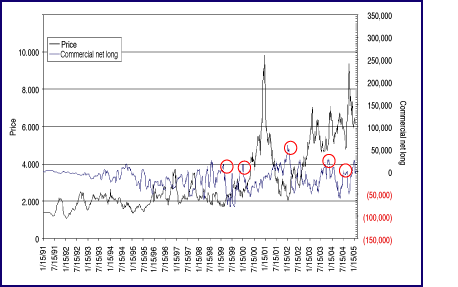The Truth Could Set You Free
Commitment Of Traders Report: Demystified
by Jason Braswell
Debunking the myths about the COT, its traders, and their markets can help you build indicators for your own trades.
Most traders know that the Commitment of Traders (COT) essentially is a report of the open interest held by the major categories of traders. Despite this basic knowledge, there seem to be some pervasive misconceptions about the report when it comes to understanding the relationship between the market and these categories of traders. I'm going to first give a quick background on the report for those who aren't yet familiar with it, and then, using the natural gas market as an example, I'm going to show how some common assumptions about the report don't hold, at least not for all markets. Finally, I'm going to show some ways you can understand the role of each of the major players in a specific market, using this knowledge to build some useful indicators.
THE BASICS
The COT is published by the Commodity Futures Trading Commission (CFTC), and it reports the open interest, the number of existing longs or shorts, held by all the traders for a given contract. The COT then breaks those traders down into four categories:
1.Commercials, sometimes called "hedgers"How do traders get funneled into these categories? For each contract, a limit is set by the exchange on the number of open contracts a trader can have before that trader must be declared a commercial or a noncommercial. For natural gas, for example, this reporting level is 200 contracts. Hence, if a trader's open interest is fewer than 200 contracts, he or she is nonreportable. If a trader's open interest is greater than 200 contracts, he or she must declare status as a commercial or noncommercial.
2. Noncommercials, known also as "speculators" or "funds"
3. Nonreportables, also known as "smalls" or "small speculators" and
4. Spreaders.

FIGURE 1: NET LONG POSITIONS OF THE COMMERCIALS. Note how the commercials get very long at market bottoms.
Members of the commercial group must have a demonstrable need for the physical commodity corresponding to the contract; he or she must be a legitimate hedger. Members of the latter group are large speculators, such as hedge funds, and need not have such physical requirements. Finally, spreaders are traders who have both long and short positions, but in different delivery months. The CFTC has gradually increased the frequency with which these reports are issued, and they are now issued each Friday, reflecting the state of the market and its traders as of the preceding Wednesday.
...Continued in the August issue of Technical Analysis of STOCKS & COMMODITIES
Excerpted from an article originally published in the August 2005 issue of Technical Analysis of STOCKS & COMMODITIES magazine. All rights reserved. © Copyright 2005, Technical Analysis, Inc.
Return to August 2005 Contents